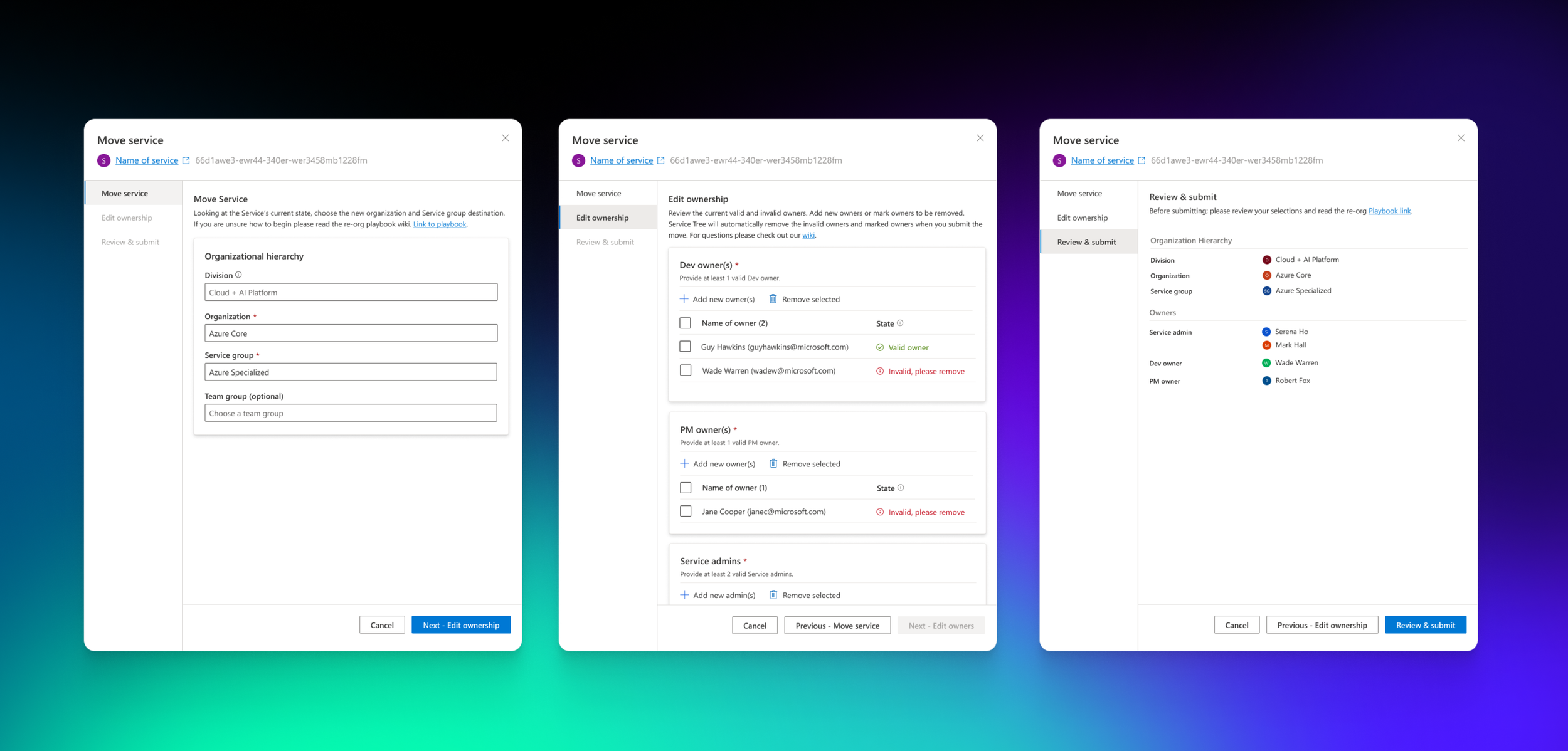Service Tree moving a service
Service Tree is a catalogue of all Services across Microsoft’s Azure. Services are organized by Organization, division, then specific teams. Each service
Crucial information about how a service can be found within Service Tree. It is important for each service to be properly maintained.
Occasionally with re-orgs or team changes, Services must be moved to the and the information needs to be updated accordingly.
Joining the team
Myself and the Engineering Systems design team were recently re-orged. Service Tree was another product added to our team charter. I was assigned to partner with the Product team to improve the user experience of the new website and UI.
The Service Tree teams design maturity was Emergent; based on Nelson Normans 6 levels. My goal was to improve the UX maturity on the team and implement a stronger partnership with the Product and Dev team.
User engagement
There was a lack of trust in the value and efficiency of the previous team’s UX process. This led to resistance from the Product team, who advocated for skipping critical research and validation stages to meet aggressive timelines.
To build trust in our team and the UX process, I introduced a streamlined UX process built on Jake Knapp Design Sprint methodology. This time-boxed process ensured collaborative alignment and delivered validated learning in days, not weeks, thus proving the strategic value of design iteration without sacrificing speed.
Old engagement timeline
Sprint based engagement timeline
Goals
Business Goals:
Create a clear experience to easily “move a service”
Reduce Product Management time spent by delivering a clear and documented user experience.
Eliminate confusion around service ownership
UX Goals:
Create an experience based on user feedback
Validate our design assumptions
Move fast
Build a strong relationship with Product stakeholders
Validation & testing
With the help of 1 User Researcher. We conducted a comparative study with 3 users.
Outcome:
We were able to validate a solution in 1 day. 3 out of 3 users agreed that 1 of the 2 variations for the new experience would be an improvement.
“This is fantastic. I want to thank you so much for reaching out sharing early with me and giving me an opportunity to help shape the future here. This is this is tremendous. I really do think this is going to help a lot of the folks like me across Microsoft.”
Designs
New entry points
Previously users would have to edit their metadata, then go through a confusing process to move their service. The entry point was non-discoverable and most of the questions in office hours was “Where do I move my service?”. Based on feedback I decided to put two entry points. 1 can be found on the landing page of a service. The second can be found in the service’s metadata.
Stepped process
The new experience now had three steps.
Choosing the new location for the service (where it is going)
Checking to make sure that owners are updated
Reviewing and confirming your selections
Editing ownership
Understanding which owner was valid vs invalid was the most painful part of moving a service.
Users would have to reach out to each owner via email or teams to check if they are re-orged and are a valid owner. This took several days to complete.
I’ve updated the process now to show when owners are no longer valid and actions to delete and change owners.
User delight
In the final validation sessions, we received positive sentiment from 3/3 users for the new engagement model. They were exceedingly happy to participate in the sessions happy to take the time to improve the UX for themselves and others.
“This is fantastic. I want to thank you so much for reaching out sharing you know with you know early with me here giving me an opportunity to help shape the future here. This is this is tremendous. I really do think this is going to help a lot of the folks like me across Microsoft.”
Post Deployment
Once the experience was released to all users, we were able to gather positive indicators that the engagement model was a success and the new experience was working as intended.
Operational Efficiency
Reduced the Product Manager time spent explaining the experience by from 2 hours or more a week to less than an hour a week.
Processes improvements
Developed a successful, high-speed UX engagement model/framework that was subsequently standardized and replicated across all following feature development cycles.
UX Maturity
Strengthened stakeholder trust in the value of the design process, leading to earlier UX involvement and improved collaboration on future initiatives.



